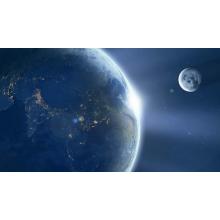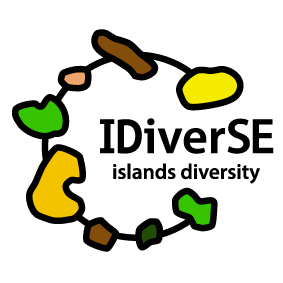
Hosted by OSOS , contributed by pprouse on 24 December 2023
Introduction
Hello there explorer,
Have you ever looked to the Moon? This activity will guide you to an observational project where you'll record daily observations of our nearest neighbour in space. While you complete your observation log, interact with your community to share knowledge about the moon phases.
Information for teachers
This accelerator was created in the framework of the project - IDiverSE (Islands Diversity for Science Education - 2017-1-PT01-KA201-035919), co-financed by the Erasmus+ agency of the European Union).

This is a STEAM activity that targets students from 5th to 12th grade, but adaptable to younger students. The texts are directed to the teacher. Teachers are invited to explore it, copy it and edit whatever they feel necessary before they share it with their students.
Supporting documents and translations to other languages can be found through the following link: https://idiverse.eu/design-thinking-with-the-moon/
For any additional info on this accelerator, please contact info@idiverse.eu
Learning Objectives
Students will contact the scientific method in an Inquiry-Based activity that will lead them to learn important concepts about the Earth-Moon-Sun system.
While going through this project, students will develop fundamental skills such as problem solving, critical thinking, communication, creativity and collaboration. They will also develop other important skills such as tolerance and respect since they will be collaborating with students from different cultures and different environments.
Opportunities to collaborate with other stakeholders
Students will be challenged to interview, discuss and collaborate with their families and other community members as well as to collaborate with participants from different regions of the world. Teachers should encourage students to share their findings in a collaborative platform as well as with family members and any other important stakeholders.
More specifically:
1 - In the Feel phase, students will use a collaborative platform to collect data and compare it with data from other communities.
2 - In the Imagine phase, students will be advised into bringing the problem to their families and have important discussions about the causes and solutions to the problem at hands.
3- In the Create phase, students will be encouraged to design a realistic model of the Earth-Moon-Sun system that explains lunar phases and eclipses.
4 - In the Share phase, students will reach out to the whole community to share their work.
Responsible Research and Innovation
One of the key aspects of OSOS is the inclusion of RRI - Responsible Research and Innovation - principles (RRI-Tools.eu). This is how this accelerator fits in the RRI model:
|
Governance |
This accelerator is based on a fundamental key point which is to teach students what science is and how to make a valid and respectful science research. It highlights the fact that science needs to be shared in order to be valid, it needs to be transparent and collaborative so as to contribute to the development of our society. In this project, students reflect with the community on the problem. Furthermore, students will share their results and conclusions with other communities worldwide, through a platform called globallab. |
|
Public engagement |
Students will interview their communities. After collecting their data, students will discuss with their parents, other family members, friends, community, etc, about the answers they collected. The whole activity will focus on the engagement of students with their community so they can converge on the best answers to their questions. |
|
Gender Equality
|
The problematic involved in this project is transversal for all humans in the world, regardless of their gender. At no moment, the gender of the students will be asked or relevant. On the resources created for the teachers advise is given in order to provide equal opportunities, not only for both genders but also among all the different personalities. In the guidelines given to the students an effort is made to use both male and female role models as inspiration, as well as male and female icons and individuals in pictures. Teacher are also advised to find experts of all genders and invite them to work with their students. |
|
Science Education |
Students will be engaged in Inquiry-Based activities that will lead them through the scientific method and reasoning. It is expected that after creating their projects, students will have understood what science is and how scientific knowledge can be obtained and communicated. By working with the community and sharing their work in the end, students will bring science education to their community as well as awareness for important scientific questions. |
|
Ethics |
During the project students will understand that cooperating and collaborating is a much more valuable effort than competing, and that knowledge and good ideas should be used in an ethical way and shared with others. When in collaboration, Scientists can overcome nearly any obstacle and provide what is necessary for a safe, developing and growing society |
|
Open Access |
After finishing their research, students will share all their work with the community, providing a fully open access to their data and conclusions. |
Paul Prouse Teacher of Physics
- Telephone: +44 (0)1527 579679 Ext. 282
- Email: pprouse@bromsgrove-school.co.uk
- LinkedIn: https://www.linkedin.com/in/pprouse
Feel

STEP 3. Collaborating with students from other locations: investigating globally
Globallab is a platform where students can introduce data they have collected, by answering to a form, and then compare it with the same data collected by students all over the world.
Using this platform, students will be able to compare their registers with other participating schools in different regions of the world. It is expected that this comparative study will raise discussions about the different appearance of the Moon in these different locations at the same time, especially locations in different hemispheres.
In case you don't have parent consents, you can create code names for the students and make sure your students use the codes and don't add any personal information in the platform. Each students should create an account and add the information collected.
You can find the project here: https://globallab.org/en/project/cover/my_moon_journal.en.html#.XoYeo4hKg2w
Keeping record
During the process, students should record all the details of their research and make the photographic record and if they want, make short videos of the activity.
Students should keep a constant record of their work here in their OSOS project, including pictures of the whole process and print screens of their most relevant graphics, maps, etc.
Imagine
Is the Moon shape the same every day?
No, the shape of the Moon, as seen from Earth, changes throughout its lunar cycle. This is due to the changing positions of the Moon, Earth, and the Sun. The Moon goes through phases, such as full moon, new moon, crescent, and gibbous, as it orbits Earth.
When is the Moon visible in the sky?
The Moon is visible in the sky during various phases of its cycle. It is most visible during the night, but depending on its phase and position relative to the Sun, it can sometimes be visible during the day.
Is it possible to discern any features on the Moon's surface?
Yes, the Moon's surface features, such as craters, mountains, and plains, are visible through telescopes. The prominent dark and light areas on the Moon are called lunar maria and highlands, respectively.
Does the Moon always show the same face to us?
Yes, the Moon is tidally locked to Earth, meaning it always shows the same face, or "near side," to us. The other side, the "far side" or "dark side," is not visible from Earth without spacecraft.
What path does the Moon trace in the sky?
The Moon follows an apparent east-to-west path across the sky due to Earth's rotation. Its specific path depends on its position in its orbit and the observer's location on Earth.
How long does it take for the Moon to repeat its cycle?
The lunar cycle, from one new moon to the next, takes approximately 29.5 days. This period is known as a synodic month.
Is there night and day on the Moon?
Yes and no. The Moon experiences a day and night cycle, but it is much longer than Earth's. A lunar day (from sunrise to sunrise) lasts about 29.5 Earth days, and the same goes for a lunar night.
What is moonlight?
Moonlight is the reflected sunlight that reaches Earth from the Moon. The Moon itself does not emit light but reflects sunlight, making it visible in the night sky.
What are moon eclipses?
Moon eclipses occur when the Earth passes between the Sun and the Moon, causing Earth's shadow to be cast on the Moon. There are two types of lunar eclipses: penumbral, where the Moon passes through Earth's penumbral shadow, and umbral, where the Moon passes through Earth's umbral shadow, resulting in a partial or total lunar eclipse.
Create

